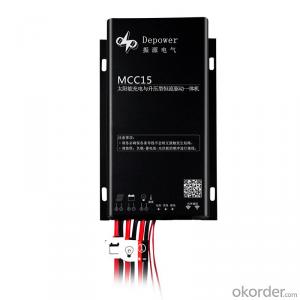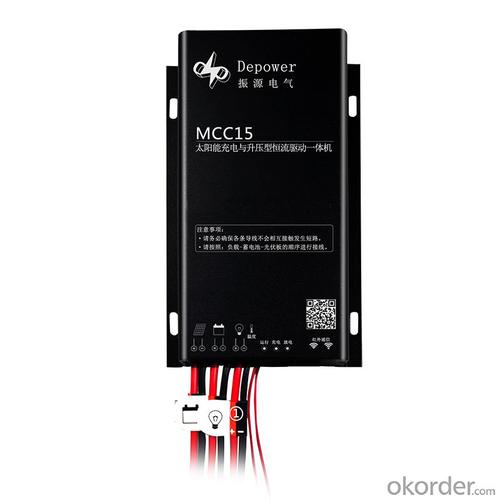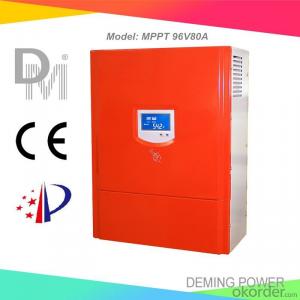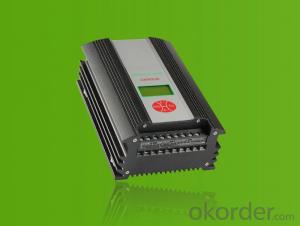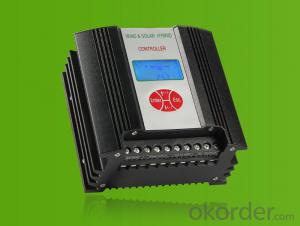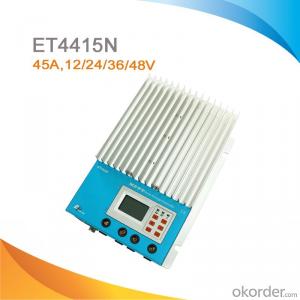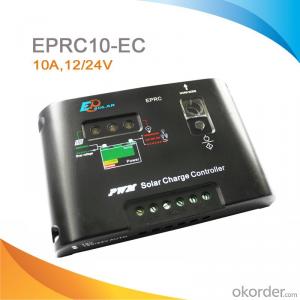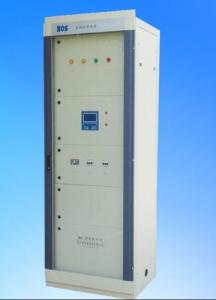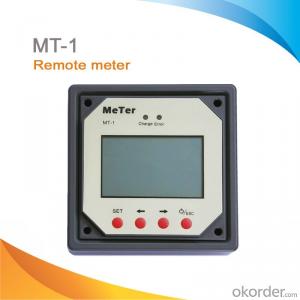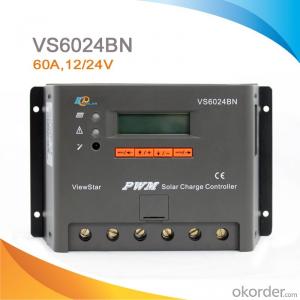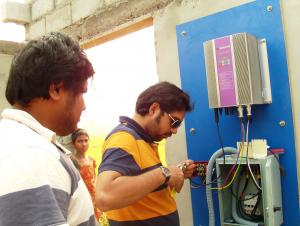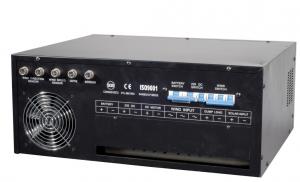High efficiency 12V 10A MPPT Solar Charge Controller for Solar Panel Street light
- Loading Port:
- China main port
- Payment Terms:
- TT OR LC
- Min Order Qty:
- 1 pc
- Supply Capability:
- 1000 pc/month
OKorder Service Pledge
OKorder Financial Service
You Might Also Like
Features :
1). Lighting control,times control,dimming range , motion sensor and so on intelligent drive LED light.
2). High tracking efficiency up to 99.9%, promote system efficiency and decrease cost.
3). Peak conversion efficiency of 98.4%
4). Automatic PV power limit function
5). Multi-function LCD displays system information intuitively
6). User programmable for battery types, load control etc.
7). 3-Stage stage MPPT charging, boost and float charging based on temperature compensation.
8).Fully programmable function via remote meter, PC software and Mobile APP.
9). Waterproof IP68 garde without any button.Technical Parameter:
Model
MCC10
Battery Type
Lead-acid or lithium battery
Battery Voltage(V)
12
Max. Charging Current(A)
10
Low voltage disconnect(V)
10.8
Battery Input Voltage Range(V)
8~15
MPPT charge (V)@25℃
≤14.4(12V)
Boost charge (V)@25℃
≤14.4(12V)
Float charge(V)@25℃
13.8(12V)
Deep discharge protection,
Cut-off voltage(V)@25℃
10.8(12V)
Reconnect Voltage(V)@25℃
11.8(12V)
Battery Temperature Compensation
-4mV/℃/2V
Panel Voltage(V)
≤35
PV Voltage@ Lighting off(V)
≤5
Max. panel power(W)
130
MPPT Tracking Range(V)
14≤Vp≤125(12V)
Output Current Range(mA)
50~4000
Waterproof Grade
IP68(1.5m,72h)
Working Environment Temperature(ºC)
-35ºC ~+60 ºC
3. Image
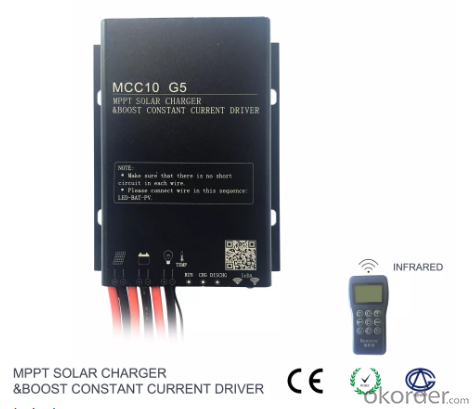
4. FAQ
Q:DO YOU HAVE ANY CERTIFICATION FOR YOUR PRODUCTS?
A:We have ISO9001:2015,CE、RoHS certifications for all of our products.
Q:DO YOU HAVE MOQ FOR PLACE ORDER?
A:Low MOQ,1pe for sample checking is available
- Q: What are the advantages of using a solar controller in a solar power system?
- The advantages of using a solar controller in a solar power system are numerous. Firstly, it helps regulate the charging process of the battery, ensuring optimal charging and preventing overcharging or deep discharging. This extends the lifespan of the battery and improves its overall performance. Additionally, a solar controller provides protection to the solar panels by preventing reverse current flow during nighttime or low light conditions. This safeguards the panels from potential damage and maximizes their efficiency. Moreover, a solar controller typically features built-in temperature compensation, which adjusts the charging voltage according to the temperature. This compensates for fluctuations in temperature and ensures consistent and efficient charging of the battery. Furthermore, many modern solar controllers come with advanced features such as LED displays, programmable settings, and data logging capabilities. These features enable users to monitor and optimize the performance of their solar power system, making it more user-friendly and efficient. Overall, using a solar controller in a solar power system offers advantages such as battery protection, increased efficiency, temperature compensation, and enhanced system monitoring capabilities.
- Q: How does a solar controller handle battery short-circuit protection?
- A solar controller handles battery short-circuit protection by implementing a variety of safety measures. Firstly, it typically monitors the battery voltage and current flow. In the event of a short circuit, the controller detects the sudden increase in current and immediately shuts off the flow of electricity from the solar panels to the battery. This prevents any further damage or potential hazards. Additionally, solar controllers often incorporate built-in fuses or circuit breakers that trip in case of a short circuit. These protective devices are designed to disconnect the battery from the solar panels, isolating the short-circuited portion of the circuit and preventing any potential damage to the battery or the controller itself. Furthermore, some advanced solar controllers also feature electronic protection mechanisms such as overcurrent protection and overload protection. These safeguards continuously monitor the current flow and voltage levels, and if they detect any abnormal or dangerous conditions, they quickly shut down the charging process to prevent any harm to the battery or the overall system. Overall, a solar controller's battery short-circuit protection is a crucial aspect of its design, ensuring the safety and longevity of the battery and the entire solar power system.
- Q: Can a solar controller be used with a solar-powered GPS tracker?
- Yes, a solar controller can be used with a solar-powered GPS tracker. A solar controller helps regulate the charging and discharging of the battery by optimizing the power generated from the solar panels. This ensures efficient energy management and extends the battery life of the GPS tracker, making it an ideal companion for solar-powered devices.
- Q: How does a solar controller handle different charging stages?
- A solar controller manages different charging stages by regulating the flow of electricity from the solar panels to the battery. It monitors the voltage and current levels to ensure efficient charging and prevent overcharging. During bulk charging, the controller allows maximum current flow to quickly recharge the battery. In the absorption stage, the controller gradually reduces the charging current to avoid overcharging and sustain the battery capacity. Finally, in the float stage, the controller maintains a lower voltage to keep the battery at a fully charged state without causing any damage.
- Q: Can a solar controller be used with solar panel backpacks?
- Yes, a solar controller can be used with solar panel backpacks. A solar controller helps regulate the charging process and protects the batteries from overcharging or over-discharging. It ensures optimal performance and longevity of the batteries, making it a useful component for solar panel backpacks that have built-in battery systems.
- Q: How does a solar controller handle battery low voltage recovery?
- A solar controller handles battery low voltage recovery by monitoring the battery voltage levels and automatically initiating a recharging process when it detects that the voltage has dropped below a predefined threshold. This ensures that the battery is constantly maintained at an optimal charge level and prevents over-discharging, which can damage the battery. The solar controller regulates the charging process, gradually increasing the voltage and current supplied to the battery until it reaches the desired charge level, thus facilitating the recovery of the battery's low voltage.
- Q: Can a solar controller be used with solar panels that are mounted on a pole?
- Yes, a solar controller can be used with solar panels that are mounted on a pole. The solar controller is responsible for regulating the flow of electricity from the solar panels to the battery or grid, regardless of the mounting location of the panels.
- Q: How do I ensure compliance with local regulations when installing a solar controller?
- To ensure compliance with local regulations when installing a solar controller, it is crucial to research and understand the specific requirements and guidelines set forth by your local authorities or governing bodies. This may include obtaining necessary permits, following electrical codes, adhering to zoning restrictions, and complying with any safety standards. It is advisable to consult with a licensed professional or qualified installer who is well-versed in local regulations to ensure a compliant and safe installation process.
- Q: How do I clean and maintain a solar controller?
- To clean and maintain a solar controller, follow these simple steps: 1. Switch off the solar controller and disconnect it from the power source. 2. Use a clean, dry cloth or a soft brush to gently remove any dust or debris from the surface of the controller. 3. If there are stubborn stains or dirt, dampen the cloth with a mild soapy water solution and carefully wipe the controller. Avoid using harsh chemicals or abrasive materials that may damage the surface. 4. Pay attention to the vents or cooling fans, and use a can of compressed air or a soft brush to remove any dust or dirt that may have accumulated there. 5. Inspect the wiring connections to ensure they are secure and free from any corrosion. If you notice any loose or damaged wires, consult a professional for repairs. 6. Finally, re-connect the solar controller to the power source and switch it on. Monitor its performance regularly to identify any issues that may require further maintenance or professional assistance.
- Q: How does a solar controller handle voltage drops in long wires between the solar panel and battery?
- The use of Maximum Power Point Tracking (MPPT) is a technique employed by a solar controller to address voltage drops in long wires between the solar panel and battery. This electronic system constantly monitors the solar panel's voltage and current output, adjusting the input voltage to the battery to ensure the maximum transfer of power. When voltage drops occur in long wires, the solar controller detects this decrease and compensates by increasing the input voltage from the solar panel. This compensates for any losses and ensures that the battery still receives the maximum power from the solar panel, even if there is a drop in voltage due to resistance in the wires. Furthermore, solar controllers often come equipped with built-in mechanisms for voltage regulation and protection. These mechanisms stabilize the voltage and safeguard the battery from overcharging or undercharging. They are capable of detecting when the voltage falls below a certain threshold and taking appropriate action to prevent any harm to the battery. In conclusion, a solar controller is designed to effectively handle voltage drops in long wires through the utilization of MPPT technology and the implementation of voltage regulation and protection mechanisms. This guarantees that the solar panel's power output is maximized and that the battery receives the necessary voltage for efficient charging, regardless of any losses that may occur in the wires.
Send your message to us
High efficiency 12V 10A MPPT Solar Charge Controller for Solar Panel Street light
- Loading Port:
- China main port
- Payment Terms:
- TT OR LC
- Min Order Qty:
- 1 pc
- Supply Capability:
- 1000 pc/month
OKorder Service Pledge
OKorder Financial Service
Similar products
Hot products
Hot Searches
Related keywords
